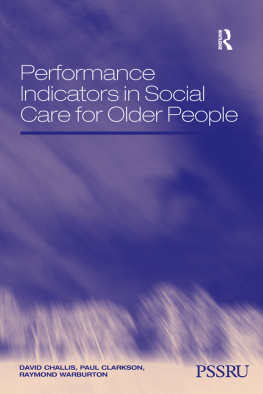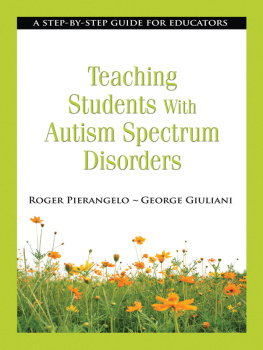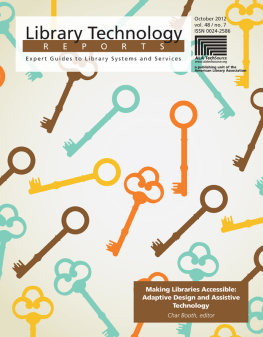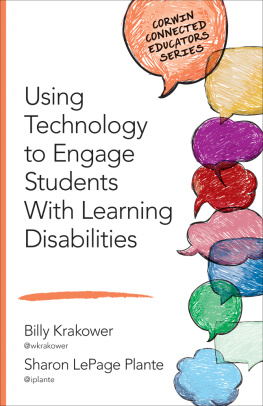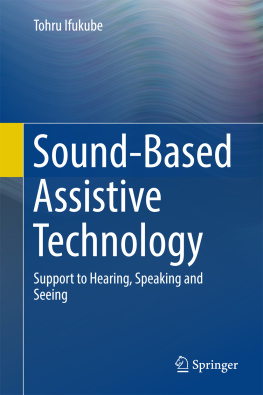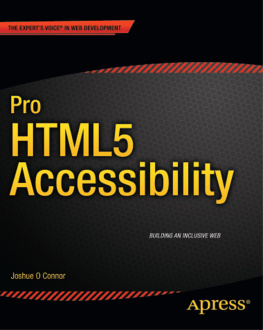
Copyright 2015 by the QIAT Leadership Team and CAST, Inc.
All rights reserved. No part of this publication may be reproduced or transmitted in any form or by any means, electronic or mechanical, including photocopy, recording, or any information storage and retrieval systems, without permission in writing from the publisher.
Library of Congress Control Number 2015946662
Paperback ISBN 978-0-9898674-5-0
Ebook ISBN 978-0-9898674-6-7
Library Edition ISBN 978-0-9898674-7-4
Published by
CAST Professional Publishing
an imprint of CAST, Inc.
www.castpublishing.org
CAST Professional Publishing
40 Harvard Mills Square/Suite 3/Wakefield, MA 01880
Publishers Cataloging-In-Publication Data
(Prepared by The Donohue Group, Inc.)
Quality indicators for assistive technology : a comprehensive guide to
assistive technology services / the QIAT Leadership Team: Gayl Bowser
[and 10 others].
pages cm
The QIAT Leadership Team: Gayl Bowser, Diana Foster Carl, Kelly S. Fonner, Terry Vernon Foss, Jane Edgar Korsten, Kathleen M. Lalk, Joan Breslin Larson, Scott Marfilius, Susan R. McCloskey, Penny R. Reed, Joy Smiley Zabala.
Includes index.
Issued also as an ebook.
ISBN: 978-0-9898674-5-0 (paperback)
ISBN: 978-0-9898674-7-4 (library edition)
1. People with disabilitiesEducation. 2. Self-help devices for people with disabilities. 3. People with disabilitiesServices for. 4. Special educationTechnological innovations. 5. Assistive computer technology. 6. Social indicators. I. Bowser, Gayl. II. QIAT Leadership Team.
LC4019 .Q53 2015
371.9/0432015946662
APA Citation: QIAT Leadership Team (2015). Quality indicators for assistive technology: A comprehensive guide to assistive technology services. Wakefield, MA: CAST Professional Publishing.
Cover and interior design by Happenstance Type-O-Rama.
Printed in the United States of America.
To all of the dedicated individuals with and without disabilities, the families, professionals, and countless others who work hard every day to ensure that people with disabilities have the assistive technology devices and services they need to participate fully in all that life has to offer.
Preface
The development of the Quality Indicators for Assistive Technology (QIAT) began in the summer of 1998 when 14 assistive technology (AT) service providers from across the nation gathered to share common concerns about the complexity of issues and processes related to AT training and service delivery. We each had a history of experience and leadership in AT in K12 school settings. Many of us were engaged in professional development about AT and improving AT services at the local, state, or national level. Some were also parents or family members of individuals with disabilities. We were, by intention, geographically and professionally diverse. Many participants in this original core group, now known as the QIAT Leadership Team, have continued to actively guide the ongoing development of the QIAT work over the years.
Early in our discussions we recognized there were no consistent, clearly-defined descriptors of quality AT services to guide the alignment of our professional development efforts. When faced with this void, we decided to create a set of descriptors that would be widely applicable and could serve as unifying guidelines for quality AT services, regardless of geographic location or service delivery model. We realized early on that quality indicators would be most readily understood and usable if they were closely aligned to the major activities associated with the delivery of AT services in schools across the country. Based on concerns from the field, our initial focus was on AT consideration, assessment, implementation, and evaluation of effectiveness. In preparation for developing the initial drafts of the descriptors in each of these areas, we explored the standards developed by the Joint Committee on Standards for Educational Evaluation and used their format as a model for our efforts (Joint Committee on Standards, 1994).
Expanded Input
Soon after the initial work was produced, we began engaging others in sharing, improving, and expanding the content through interactive sessions at local, state, national, and international conferences. Over the years, these sessions included over 4,000 individuals who participated in critical discussion of the Quality Indicators, and provided oral and written suggestions for the continuing development of collaborative efforts.
Throughout the development of QIAT, the ideas gained from participants at conference sessions served as the basis for revision and continued refinement of the Quality Indicators. In addition, participants assisted in determining the perceived value of QIAT, not only to conference participants but also to others with similar responsibilities and interests. Over 2,000 written responses and many hours of collegial conversations convinced us that QIAT could be useful to those concerned with the development and delivery of AT services with a variety of perspectives ranging from students and families to school staff and policy makers.
To gain even more input, we held QIAT Summits, inviting anyone interested in AT services. These three-day meetings expanded the number of people who participated in the development and writing of the quality indicators and increased the amount of time for participation. Summits were face-to-face work sessions that took place in many regions of the country, which provided an opportunity to gather information on variations in regional practices. Over the years they were held in Missouri (1999), Kansas (2001), Oregon (2003), Georgia (2005), Texas (2007), Minnesota (2009), Florida (2010), and Arkansas (2011). In a series of sessions, participants worked collaboratively in large and small groups to review, revise, refine, and expand the Quality Indicators. Over the years, this work deepened the understanding of the purpose, scope, and potential uses of the Quality Indicators and led us to develop tools that can be used to assist with the development and implementation of high-quality AT services (e.g., self-evaluation matrices for each indicator, guidance documents, and a variety of forms for specific uses).
In 2004, Joy Zabala conducted a study that sought to establish the perceived importance, validity, and utility of the first six areas of Quality Indicators to five different groups: AT users and family members, AT service providers, K12 administrators, higher education professionals, and policy makers. (Zabalas research did not include transition or professional development.) Their input affirmed the importance, validity, and utility of the main ideas of each of the Quality Indicators across all groups (Zabala, 2007). Their suggestions for minor changes to improve clarity led us to revise the wording of several of the indicators in 2005.
Dissemination
We began disseminating the QIAT work almost immediately after the development of the initial indicators knowing that the engagement of many people was critical to the quality and utility. Dissemination included holding face-to-face interactive conference presentations and summits, developing the QIAT website (www.qiat.org), establishing the QIAT electronic list, and creating publications for consumer and research journals. This four-pronged approach enabled people with varied perspectives in different parts of the country to access the Quality Indicators, contribute actively to the ongoing work, and benefit from it.
The most active methods for sharing and participating in the QIAT work have been through the QIAT electronic mail list and website. Initially the website contained working drafts of the QIAT Indicators, a historical perspective of the work, information on ways to support ongoing collegial conversations, and an invitation to join the QIAT electronic mail list. The website has evolved with the work and now includes copies of the Indicators, supporting documents, links to research related to QIAT work, and a range of resources submitted by QIAT electronic mail list participants. Readers are encouraged to sign up for the QIAT list, following links on the website.
Next page

